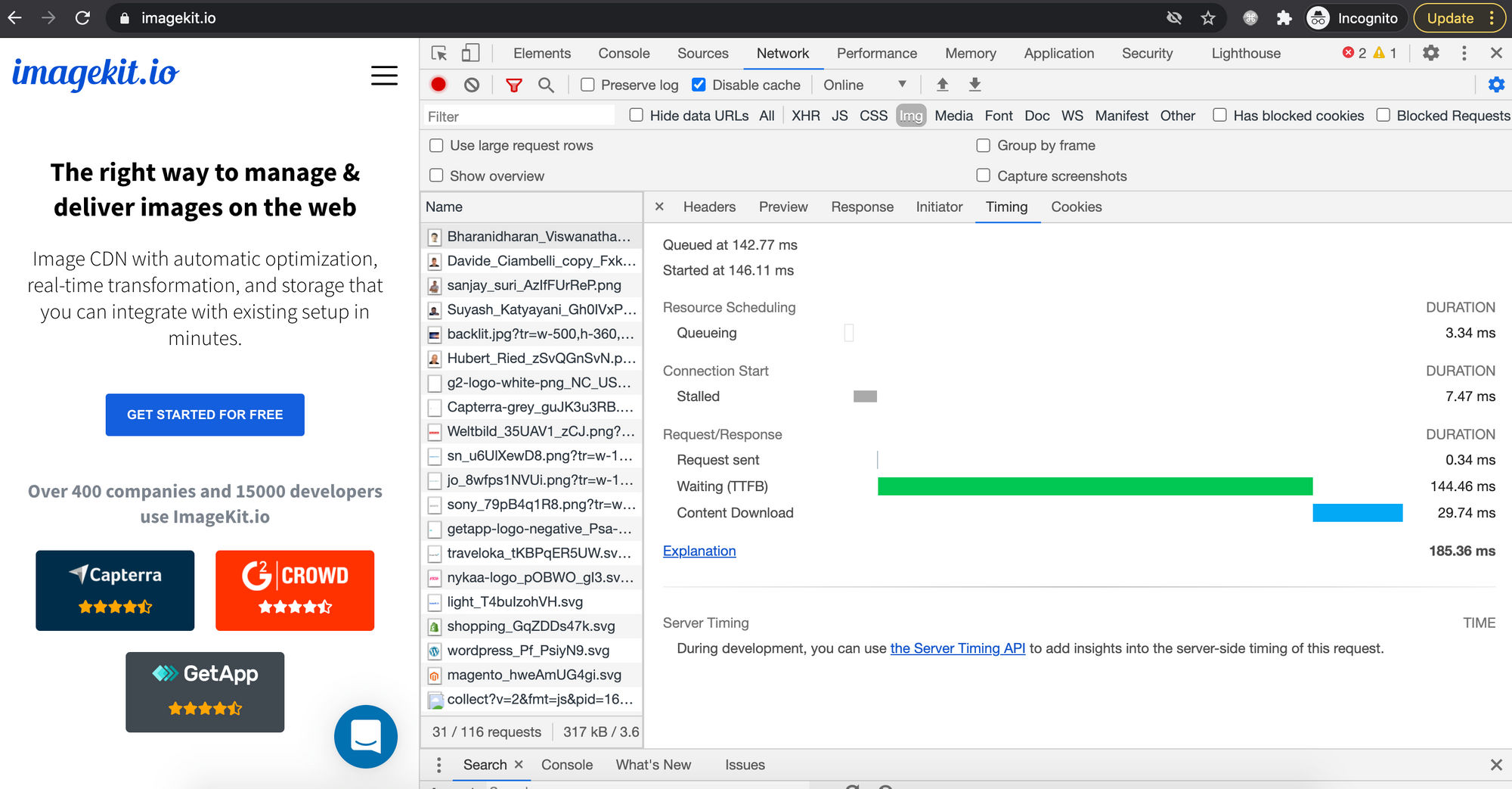How To Enlarge The Size Of An Image
If your paradigm doesn't fit the layout, you can resize it in the HTML. Ane of the simplest ways to resize an image in the HTML is using the height and width attributes on the img tag. These values specify the height and width of the epitome chemical element. The values are set in px i.e. CSS pixels.
For example, the original image is 640×960.
https://ik.imagekit.io/ikmedia/women-dress-ii.jpg 
We can render it with a pinnacle of 500 pixels and a width of 400 pixels
<img src="https://ik.imagekit.io/ikmedia/women-dress-2.jpg" width="400" tiptop="500" /> 
If the paradigm element's required height and width don't friction match the image's actual dimensions, and so the browser downscales (or upscale) the image. The exact algorithm used past the browser for scaling tin can vary and depends on the underlying hardware and OS.
At that place are a couple of downsides of customer-side image resizing, mainly poor image quality and slower image rendering. To overcome this, you should serve already resized images from the server. Y'all tin can use Thumbor or a gratis image CDN similar ImageKit.io to resize images dynamically using URL parameters.
Resizing an image in CSS
You can also specify the height and width in CSS.
img { width: 400px, summit: 300px } Preserving the aspect ratio while resizing images
When you specify both superlative and width, the prototype might lose its aspect ratio. You lot can preserve the aspect ratio past specifying simply width and setting height to machine using CSS holding.
img { width: 400px, height: machine } This will render a 400px broad epitome. The tiptop is adjusted appropriately to preserve the aspect ratio of the original image. You tin can also specify the tiptop attribute and ready width equally auto, simply most layouts are more often than not width constrained and not peak.
Responsive image which adjusts based on bachelor width
You can specify the width in pct instead of an absolute number to make it responsive. By setting width to 100%, the image volition scale upwardly if required to match the parent element's width. It might result in a blurred prototype as the epitome can be scaled up to exist larger than its original size.
img { width: 100%; height: auto; } Alternatively, y'all can utilise the max-width property. By setting
max-width:100%; the image will scale down if it has to, merely never scale up to be larger than its original size.
img { max-width: 100%; acme: auto; } How to resize & ingather prototype to fit an element surface area?
So far, we have discussed how to resize an prototype by specifying height or width or both of them.
When you specify both elevation and width, the image is forced to fit the requested dimension. It could change the original attribute ratio. At times, you lot want to preserve the aspect ratio while the image covers the whole area fifty-fifty if some part of the paradigm is cropped. To achieve this, you lot can utilize:
- Background image
-
object-fitcss property
Resizing groundwork epitome
background-prototype is a very powerful CSS property that allows you to insert images on elements other than img. You can control the resizing and cropping of the image using the following CSS attributes-
-
groundwork-size- Size of the image -
background-position- Starting position of a background image
background-size
Past default, the groundwork image is rendered at its original full size. You tin can override this by setting the elevation and width using the background-size CSS property. You can scale the paradigm upward or downward every bit you wish.
<manner> .background { background-paradigm: url("/image.jpg"); background-size: 150px; width: 300px; tiptop: 300px; edge: solid 2px red; } </style> <div class="background"> </div> Possible values of background-size:
-
auto- Renders the image at full size -
length- Sets the width and superlative of the groundwork image. The first value sets the width, and the second value sets the height. If only one value is given, the 2nd is set toauto. For instance,100px 100pxor50px. -
per centum- Sets the width and height of the background paradigm in per centum of the parent element. The first value sets the width, and the second value sets the height. If only one value is given, the 2d is set toauto. For example,100% 100%or50%.
Information technology also has 2 special values contain and cover:
background-size:contains
contains - It preserves the original aspect ratio of the image, but the image is resized so that it is fully visible. The longest of either the height or width will fit in the given dimensions, regardless of the size of the containing box.
<mode> .background { groundwork-image: url("/image.jpg"); background-size: contains; width: 300px; pinnacle: 300px; border: solid 2px cherry; } </style> <div class="groundwork"> </div> groundwork-size:embrace
cover - It preserves the original attribute ratio just resizes the image to comprehend the entire container, even if information technology has to upscale the epitome or ingather it.
<style> .background { groundwork-image: url("/paradigm.jpg"); background-size: embrace; width: 300px; summit: 300px; edge: solid 2px red; } </way> <div class="groundwork"> </div> object-fit CSS property
You can use the object-fit CSS property on the img element to specify how the paradigm should be resized & cropped to fit the container. Before this CSS property was introduced, nosotros had to resort to using a background paradigm.
Along with inherit, initial, and unset, in that location are 5 more possible values for object-fit:
-
comprise: It preserves the original aspect ratio of the prototype, simply the image is resized and then that information technology is fully visible. The longest of either the height or width will fit in the given dimensions, regardless of the size of the containing box. -
cover: Information technology preserves the original attribute ratio but resizes the image to embrace the entire container, fifty-fifty if it has to upscale the image or crop it. -
fill: This is the default value. The image will fill its given expanse, fifty-fifty if it means losing its aspect ratio. -
none: The paradigm is not resized at all, and the original image size fills the given expanse. -
scale-downwardly: The smaller of either incorporate or none .
You can use object-position to control the starting position of the image in case a cropped part of the image is being rendered.
Permit's empathise these with examples.
The following epitome'southward original width is 1280px and superlative is 854px. Here information technology is stretching to maximum available width using max-width: 100%.
<img src="https://ik.imagekit.io/ikmedia/backlit.jpg" style="max-width: 100%;" /> 
object-fit:contains
<img src="https://ik.imagekit.io/ikmedia/backlit.jpg" manner="object-fit:contain; width:200px; height:300px; border: solid 1px #CCC"/> The original aspect ratio of the image is aforementioned, just the prototype is resized then that it is fully visible. We accept added 1px border around the image to showcase this.

object-fit:cover
<img src="https://ik.imagekit.io/ikmedia/backlit.jpg" fashion="object-fit:comprehend; width:200px; height:300px; border: solid 1px #CCC"/> The original attribute ratio is preserved but to cover the whole area epitome is clipped from the left and right side.

object-fit:fill
<img src="https://ik.imagekit.io/ikmedia/backlit.jpg" style="object-fit:fill; width:200px; summit:300px; border: solid 1px #CCC"/> Paradigm is forced to fit into a 200px wide container with summit 300px, the original aspect ratio is not preserved.

object-fit:none
<img src="https://ik.imagekit.io/ikmedia/backlit.jpg" style="object-fit:none; width:200px; meridian:300px; edge: solid 1px #CCC"/> 
object-fit:scale-down
<img src="https://ik.imagekit.io/ikmedia/backlit.jpg" style="object-fit:scale-downward; width:200px; height:300px; border: solid 1px #CCC"/> 
object-fit:comprehend and object-position:correct
<img src="https://ik.imagekit.io/ikmedia/backlit.jpg" way="object-fit:cover; object-position: right; width:200px; superlative:300px; border: solid 1px #CCC"/> 
Downsides of client-side paradigm resizing
There are certain downsides of customer-side resizing that you lot should keep in mind.
ane. Slow paradigm rendering
Since the full-sized image is loaded anyway before resizing happens in the browser, it takes more fourth dimension to stop downloading and finally rendering. This means that if you lot have a large, one.v megabyte, 1024×682 photograph that you are displaying at 400px in width, the whole ane.5-megabyte paradigm is downloaded by the visitor before the browser resizes it down to 400px.
Yous can encounter this download fourth dimension on the network console, as shown in the screenshot beneath.

On the other paw, if you resize the image on the server using some plan or an image CDN, then the browser doesn't have to load a large amount of data and waste time decoding & rendering it.
With ImageKit.io, you can hands resize an epitome using URL parameters. For example -
Original image
https://ik.imagekit.io/ikmedia/women-dress-2.jpg
400px wide image with aspect ratio preserved
https://ik.imagekit.io/ikmedia/women-dress-2.jpg?tr=w-400
2. Poor image quality
The verbal scaling algorithm used by the browser tin can vary, and its performance depends upon underlying hardware and Bone. When a relatively bigger epitome is resized to fit a smaller container, the final epitome could exist noticeably blurry.
There is a tradeoff betwixt speed and quality. The terminal choice depends upon the browser. Firefox three.0 and afterward versions utilize a bilinear resampling algorithm, which is tuned for loftier quality rather than speed. But this could vary.
You can utilise the image-rendering CSS property, which defines how the browser should render an image if it is scaled upwardly or downwardly from its original dimensions.
/* Keyword values */ image-rendering: motorcar; epitome-rendering: crisp-edges; paradigm-rendering: pixelated; /* Global values */ paradigm-rendering: inherit; image-rendering: initial; image-rendering: unset; 3. Bandwidth wastage
Since the total-sized epitome is existence loaded anyhow, it results in wastage of bandwidth, which could have been saved. Data transfer is not inexpensive. In improver to increasing your bandwidth bills, it also costs your users real coin.
If you are using an image CDN, you tin further reduce your bandwidth consumption by serving images in adjacent-gen formats e.thou. WebP or AVIF.
The user friendly dashboard will besides show y'all how much bandwidth y'all have saved then far

iv. Increased retentiveness and processing requirements on client devices
Resizing large images to fit a smaller container is expensive and can be painful on low-stop devices where both retention and processing power is express. This slows down the whole spider web page and degrades the user experience.
Summary
When implementing web pages, images need to fit the layout perfectly. Here is what you need to remember to be able to implement responsive designs:
- Avert client-side (browser) resizing at all if you can. This means serve correctly sized images from the server. Information technology results in less bandwidth usage, faster image loading, and college image quality. There are many open up-source image processing libraries if yous want to implement information technology yourself. Or better, you can use a complimentary prototype CDN which will provide all these features and much more with a few lines of code.
- Never upscale a raster image i.due east. JPEG, PNG, WebP, or AVIF images, should never be upscaled as information technology will result in a blurred output.
- You lot should use the SVG format for icons and graphics if required in multiple dimensions in the pattern.
- While resizing, if you want to preserve the aspect ratio of original images - Only specify 1 of
widthandpeakand set up the other toauto. - If yous want the image to fit the entire container while preserving the aspect ratio, fifty-fifty if some part is cropped or the image is upscaled - Utilize the
object-fitCSS belongings or gear up a background image using thebackground-imageCSS belongings. - Command the starting position of the image using
object-positionwhile usingobject-fit. In groundwork images, usegroundwork-position.
How To Enlarge The Size Of An Image,
Source: https://imagekit.io/blog/how-to-resize-image-in-html/
Posted by: newmangreste.blogspot.com


0 Response to "How To Enlarge The Size Of An Image"
Post a Comment